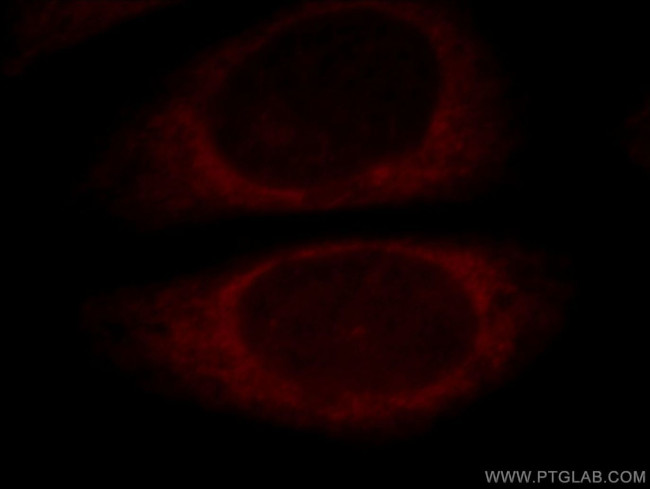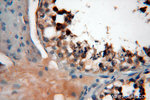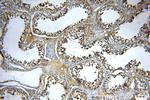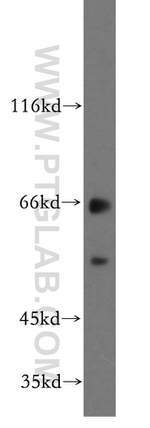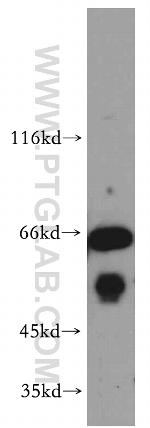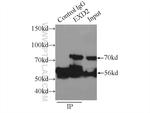Search Thermo Fisher Scientific
Product Details
20138-1-AP
Species Reactivity
Published species
Host/Isotype
Class
Type
Immunogen
Conjugate
Form
Concentration
Purification
Storage buffer
Contains
Storage conditions
Shipping conditions
Product Specific Information
Immunogen sequence: DDHSSWRKV LEKCQGVVDI PFRSKGMSRL GEEVNGEATE SQQKPRNKKS KMDGMVPGNH QGRDPRKHKR KPLGVGYSAR KSPLYDNCFL HAPDGQPLCT CDRRKAQWYL DKGIGELVSE EPFVVKLRFE PAGRPESPGD YYLMVKENLC VVCGKRDSYI RKNVIPHEYR KHFPIEMKDH NSHDVLLLCT SCHAISNYYD NHLKQQLAKE FQAPIGSEEG LRLLEDPERR QVRSGARALL NAESLPTQRK EELLQALREF YNTDVVTEEM LQEAASLETR ISNENYVPHG LKVVQCHSQG GLRSLMQLES RWRQHFLDSM QPKHLPQQWS VDHNHQKLLR KFGEDLPIQL S (272-621 aa encoded by BC001962)
Target Information
Exonuclease that has both 3'-5' exoribonuclease and exodeoxyribonuclease activities, depending on the divalent metal cation used as cofactor (PubMed:29335528, PubMed:31127291). In presence of Mg(2+), only shows 3'-5' exoribonuclease activity, while it shows both exoribonuclease and exodeoxyribonuclease activities in presence of Mn(2+) (PubMed:29335528, PubMed:31127291). Acts as an exoribonuclease in mitochondrion, possibly by regulating ATP production and mitochondrial translation (PubMed:29335528). Also involved in the response to DNA damage (PubMed:26807646, PubMed:31255466). Acts as 3'-5' exodeoxyribonuclease for double-strand breaks resection and efficient homologous recombination (PubMed:20603073, PubMed:26807646). Plays a key role in controlling the initial steps of chromosomal break repair, it is recruited to chromatin in a damage-dependent manner and functionally interacts with the MRN complex to accelerate resection through its 3'-5' exonuclease activity, which efficiently processes double-stranded DNA substrates containing nicks (PubMed:26807646). Also involved in response to replicative stress: recruited to stalled forks and is required to stabilize and restart stalled replication forks by restraining excessive fork regression, thereby suppressing their degradation (PubMed:31255466). [UniProt]
For Research Use Only. Not for use in diagnostic procedures. Not for resale without express authorization.
Bioinformatics
Protein Aliases: 3'-5' exoribonuclease EXD2; exonuclease 3''-5'' domain-like 2; Exonuclease 3'-5' domain-containing protein 2; exonuclease 3'-5' domain-like 2; Exonuclease 3'-5' domain-like-containing protein 2
Gene Aliases: 4930539P14Rik; C14orf114; C85658; EXD2; EXDL2; RGD1311087
UniProt ID: (Human) Q9NVH0, (Mouse) Q8VEG4
Entrez Gene ID: (Human) 55218, (Rat) 362759, (Mouse) 97827

Performance Guarantee
If an Invitrogen™ antibody doesn't perform as described on our website or datasheet,we'll replace the product at no cost to you, or provide you with a credit for a future purchase.*
Learn more
We're here to help
Get expert recommendations for common problems or connect directly with an on staff expert for technical assistance related to applications, equipment and general product use.
Contact tech support
